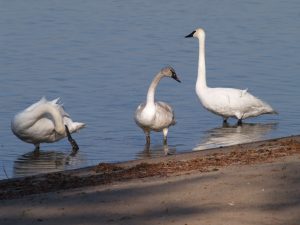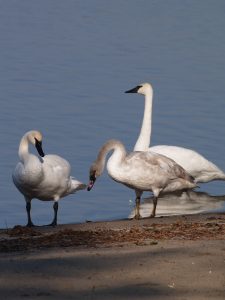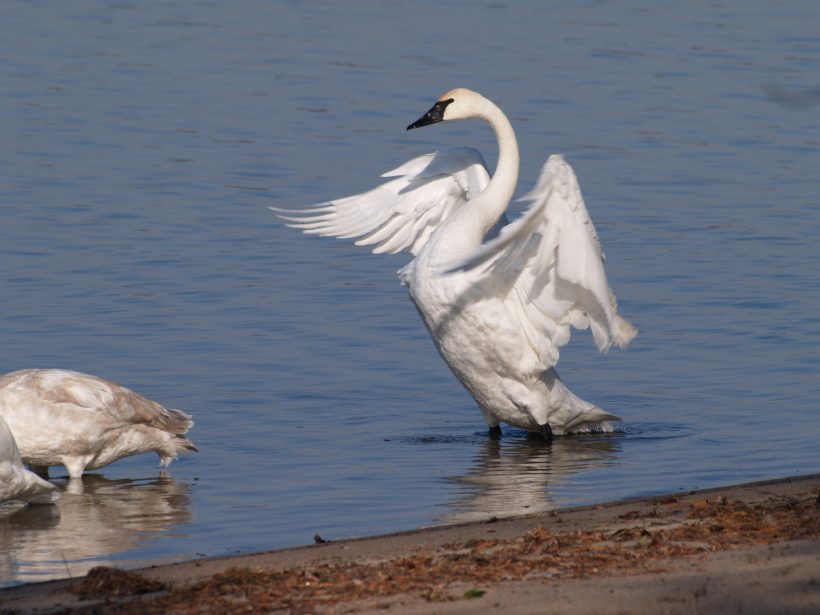OUT of DOORS with BARNEY MOORHOUSE For Reproduction Rights Call Access 1.800.893.5777
F&W REGS
Kudos to the MNRF for the 2019 Fishing and Hunting regulations. As advertised the layouts are new and improved with more accurate locational information, more detailed maps, improved photos and a larger font size to aid tired eyes while honing up on the numerous changes.
RETURN OF THE TRUMPETER
Returning from deer camp I came across some rather large white swans feeding near the shore. This prompted me to pull off further up the road and park so I could take some photos with my longer lens so as not to disturb them. Later I sent some photos to the MNRF for identification. Turned out to be Trumpeters. My correspondent commented that I was lucky to see them. That was in 2013.

The Trumpeter is North America’s largest waterfowl and it was nearly extirpated in the continent for food, its down-covered skin (for powder puffs) and feathers for quill pens ironically apparently favoured by the renowned naturalist John James Audubon. Trumpeters had been plentiful in Ontario as we know it to-day during the early 1700s.
I first wrote about the Trumpeter when then MNR employee Harry Lumsden began restoration efforts in the 80s, I believe in the Wye Marsh area. At age 95 Lumsden still continues his passion.
There are 1000+ trumpeters in Ontario to-day and they are spreading naturally. Which wasn’t always the case. Ontario’s re-introduction began with wild eggs from Alberta which were placed under the invasive mute swan for hatching. In 1993 trumpeters hatched in Ontario’s wild for the first time in more than 100 years.
The trumpeter’s wing span can reach 8 feet. They require open, fresh water that’s not too deep for feeding off the bottom. Which is probably why I saw them at the Wollaston Lake beach by the roadway. They mate for life and go south for the winter. Often they nest in the same area where the pen (the female) was born.
Initially the few birds were so inbred that many eggs did not hatch. However, in 1992 Michigan cut its swan reintroduction budget and gave Ontario 50 Alaskan eggs. Alaska, by the way, apparently has 22,000+ adult swans according to its last aerial survey conducted in 2015.

By 2002 Ontario’s trumpeter population was self-sustaining and growing.
Habitat loss due to development is significant because these birds are people shy. Which is probably why one doesn’t see so many.
BEWARE WHAT YOU WISH
John Kaplanis, Executive Director of the Northwestern Ontario Sportsmen’s Alliance (NOSA), has accepted MNRF Minister John Yakabuski’s invitation to chair the new provincial committee, the Big Game Management Advisory Committee to review Ontario’s moose management process. To say that NOSA has been critical of the ministry’s approach to moose management may well be something of an understatement. The alliance has criticized the MNRF for being inconsistent, overly cautious with regards to tag allocations and in a media release said the ministry used creative math to over-estimate the previous year’s harvest “thus forcing the moose harvest allocation formula to generate fewer adult tags” for resident hunters in NW Ontario.
Kaplanis said the BGMAC will report directly to the minister and this should improve accountability and transparency. Previous committees reported to the Director of the Wildlife Branch.
Four of the eight-member committee live in the NW. The BGMAC will also be seeking ways to improve how the MNRF manages big game such as deer, elk and black bear to ensure sustainability and hunting opportunities for future generations.
It would be even more of an understatement to say that Kaplanis evidently likes a challenge.
ANTLERLESS DEER TAGS
“The quotas for the 2019 antlerless deer tags aren’t available and are not posted in the printed summaries. The quotas will be posted online at Ontario.ca/hunting later this spring, in advance of the antlerless deer draw deadline.” (MNRF)
FROM ST. JOHN AMBULANCE – Sun Awareness Month
Excessive exposure to the sun’s ultraviolet (UV) rays increases your risk of skin cancer. Does that mean you should live in the shadows and avoid the sun at all costs? Of course not! By employing the Skin Cancer Foundation‘s precautionary measures to limit your UV exposure, you’ll be able to enjoy the sunshine and get some Vitamin D without risking your health.
Before you leave the house:
- Check the UV index. Exercise caution when it is 3 or higher.
- Dress appropriately. Light linen blocks UV while keeping you cool.
- Pack protective gear. UV sunglasses protect your eyes from sunburn; consider a wide-brimmed hat.
- Sunscreen with an SPF (sun protection factor) of 15 or higher is suitable for everyday activity; consider 30 for longer exposure. Two tablespoons over your body for best protection, every two hours or right after swimming, working out or sweating. Don’t apply to infants under 6 months. Keep them out of the sun.
- Seek shade, avoid peak hours (10 am. To 2 p.m.).
If you burn sponge the affected area with cool water, sip cool water to cool off from the inside out, apply products meant to soothe burns often containing aloe vera and if blisters appear see your doctor. You can get a sunburn while under water and if you have a tan the UVA radiation damage has already been done.
JUST CLIMATE CHANGE?
Les Stanfield is an Aquatic ecologist and the principal owner of Ecohealth Solutions in Milford, Ontario. Mr. Stanfield believes that climate change is not the only factor at play in the recent flooding issues and by thinking that this is so risks missing a major factor of this story – and the solution.
Save Our Swamps
“About 70 per cent to 80 per cent of a watershed’s area is drained by thousands of very small waterbodies, each one draining small areas. These small waterbodies – wetlands, swales, springs – are largely unmapped and unregulated. Many flow only in spring, and these capillaries of the land provide the true capacity of the watershed to store and pass water to rivers. The frequency and magnitude of flows in the receiving rivers are a direct reflection of the rate and timing of flows from these waterbodies.” (Stanfield) More to come.
AND FINALLY… Another epitaph
In a Ribbesford, England, cemetery:
“The children of Israel wanted bread
And the Lord sent them manna,
Old clerk Wallace wanted a wife,
And the Devil sent him Anna.”
Photo – by BM – Trumpeters of Wollaston Lake.
